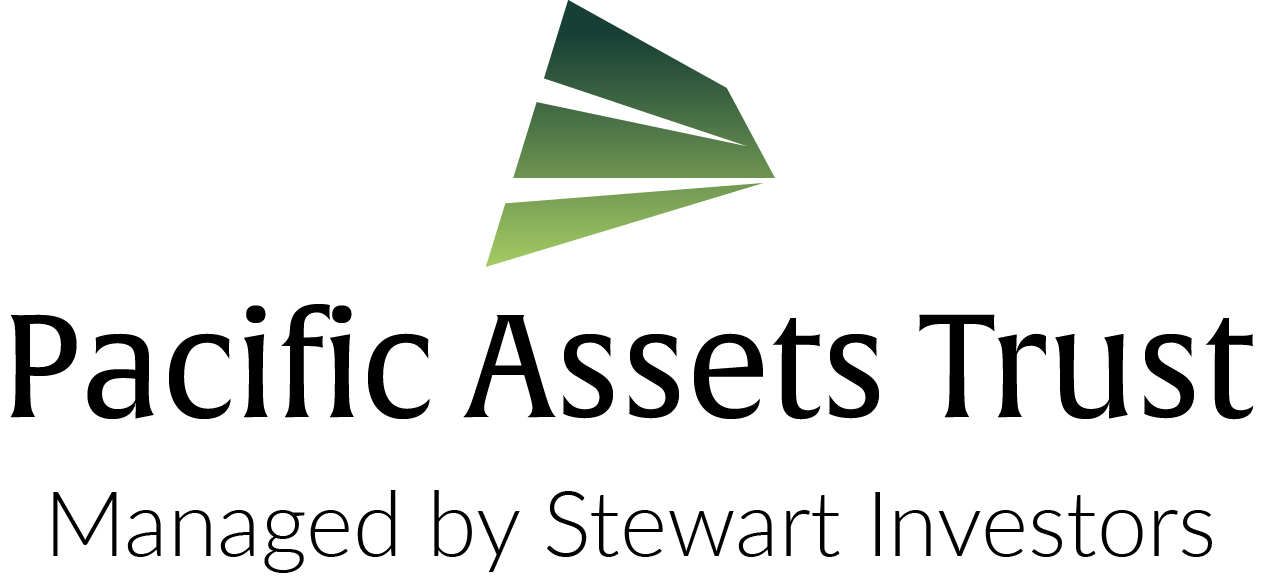
Pacific Assets Trust: thoughts from the portfolio managers
Plenty of new investment ideas
Current investment emotions are mixed. We are generating a significant number of new investment ideas for Pacific Assets Trust plc (‘the Trust’). We have bought 14 new companies in the past six months, including four from China, two from the Philippines and four from India1. This is unlike us. Our turnover2 is usually low. And it’s becoming much harder to find room in the Trust - perhaps as hard as it’s ever been - as we are reluctant to let go of any of our existing holdings. We find this is usually a good sign that strong, absolute returns are just ahead!
But significant lagging of the index due to low China weighting
However, recent performance of the Trust is a long way behind the index. While there are always many reasons for lagging performance, the simplest and most important explanation is the exceptionally strong recent bounce in China from oversold levels and the healthy correction of Indian share prices from elevated levels. The MSCI China Index is up +18% year-to-date, while the MSCI India Index is down-10% year-to-date3. Over the last 6 months to 15 March 2025, MSCI China is up +40% and MSCI India is down -16%4. A 56% performance differential. While we generate plenty of ideas in China, we currently have a much bigger weighting in India, although this is slowly changing as our confidence in new Chinese companies grows and the corporate backdrop there becomes clearer.
China weighting is growing slowly but steadily
Our China weighting in the Trust continues to grow for three main reasons. First, our universe of quality China ideas is expanding as companies navigate more difficult economic times, often for the first time in their corporate histories. This has allowed us to take a hard look at the resilience of many Chinese businesses, their basic attitude to risk and mindset of their management teams and owners. While many Chinese franchises have struggled, cut corners and diminished, a decent number have come through the other side much stronger and better positioned for growth. Second, Chinese company valuations5 have become much more attractive. This has allowed us better buying points into companies we have been waiting for on the sidelines. Third, and perhaps most importantly, the changing political landscape and US Government policy has brought increasing clarity to the new Chinese approach to shareholder interests.
China requires four rather than three golden rules
We have four golden rules when investing in China, compared with our normal three. First, the company must meet our quality requirements of management, franchise and financials. A growing number of listed Chinese companies are meeting these requirements. Second, they must be well positioned to contribute to China’s sustainable development6. On this, we are particularly well aligned with the Chinese Government in almost all aspects of sustainable development. Sustainability talk is cheap, but very few countries have walked the walk as purposefully or far as China in terms of reorientating development toward a genuine sustainable path. Human rights risk is the clear and present exception and challenge that we continue to try and navigate with an approach based on individual companies. Third, valuations must be attractive. The prolonged sell-off in Chinese assets has brought many companies back to attractive levels. We believe despite the recent bounce-from-the-bottom, valuations are still reasonable, particularly when factoring in a recovery in earnings.
Our fourth “China-specific” golden rule is the need to form a view on the Chinese Government’s “allowable return” for a particular company. This tries to capture the idea that in China, returns can erode not just with new capital and competition entering a market, but with a change of strategic view by the Chinese Government. In other words, all Chinese companies are actively regulated by the Chinese Government, whether they sell soy sauce, build toll roads or connect small businesses with consumers via online shopping platforms. Over the past decade or so, the Chinese Government appears to have taken a much more proactive approach to allowable return, built on their goals and ambitions. Great companies are not just tolerated by Beijing but embraced and encouraged as part of the development solution, but excess returns are only acceptable to facilitate national development. In order to earn extended supernormal returns in China, not only must companies have sound business fundamentals, they must also be operating in the “build-out” phase of industries of national importance, as decided by the government. The Chinese Government has been notably transparent in spelling out just what these industries are, with clear long-term development plans reaching out to 2035 and beyond.
Allowable Returns as a development model
Investing in a world of “allowable” or “capped” returns comes with challenges of its own and we are still learning. Long-term sustainable development alignment is a critical first step, but looking through a “toll-road” lens is also helpful. By this we mean, so long as new roads need to be built, toll-road companies are usually allowed to generate attractive returns well in excess of their cost of capital7 in order to reinvest in new roads. This cycle usually comes to an abrupt end once the last roadbuilding project is in sight. We are trying to apply this lens not just to our Chinese companies but more broadly. Where China leads, other countries often follow.
Risk factors
Capital at risk. The value of investments and any income from them may go down as well as up and are not guaranteed. Investors may get back significantly less than the original amount invested.
A few comments on recent portfolio activity
We have been busier than usual for three reasons.
1. Trimming expensive Indian holdings
Some, if not many, of our favourite Indian companies became very fully priced and we were left with no choice but to trim and sell, reducing our large India exposure. Examples include our favourite Indian consumer and industrial companies, Mahindra and Mahindra, Tube Investments, Godrej Consumer Products, Dabur, Marico and Tata Consumer Products. In hindsight we should have sold a little more, a lot quicker! Having trimmed, we are now comfortable with our Indian holdings at current levels and remain confident in their ability to generate good positive returns over the long term.
2. Trimming companies whose cashflows are at risk from new US Government policy
The Trust also owned several high quality Indian technology and pharmaceutical companies with significant exposure to the US. Given the unpredictable risk of US tariffs hitting their cashflows and the relatively full valuations8 they trade on currently, we have also taken the opportunity to move quickly and trim how much we hold in these companies significantly. Companies trimmed include TCS and Tech Mahindra, while we have sold out completely from Cyient, Syngene and Dr Reddy's Laboratories.
Elsewhere, we have also trimmed Taiwanese technology holdings and in particular Taiwan Semiconductor (TSMC). Whilst political influences have always been a constant for these companies, it feels as though, for the first time, Taiwanese companies are at risk of losing control over their own capital expenditure (capex) plans. This is particularly so for TSMC. Given the size of TSMC’s capex this is a significant short-term risk.
3. Picking up attractively valued companies in China, Philippines and India
We have quickly purchased three new holdings in the Philippines: Ayala, BDO Unibank and Bank of the Philippines Islands. We believe all three are high quality businesses on extremely attractive valuations in a country with strong economic fundamentals.
Likewise, we have picked up three favourite Indian companies: Bajaj Auto, Bajaj Holdings and Investment and Sundaram Finance. Bajaj Auto’s valuation has almost halved from its peak, and valuations of all three are extremely reasonable for their long-term growth prospects9.
Finally in China, we have purchased four new companies. Dongguan Yiheda Automation, Shenzhen Mindray, Alibaba and S.F. Holdings. In all four cases, share prices more than halved from their peak to our purchase points, valuations are extremely attractive, and growth prospects are solid10. Yiheda is a one-stop supply chain solution for factory automation across China. We like the power of the franchise – returns to scale, efficiency and professionalism are significant, while it is “hot-spot” agnostic. By this we mean neither the Company or ourselves need to chase the short-term capex trends of any particular company or industry. Mindray is a global leader in affordable medical devices and has been successful in using cashflows to drive its offering further up the value chain. A recent glowing reference from the CEO of one of our favourite portfolio holdings helped persuade us that Mindray’s healthy margins can be durable over time. It is well positioned to displace foreign medical device companies such as GE HealthCare and Siemens Healthineers across the Chinese hospital network for both advanced and basic medical devices as well as offering price-competitive, quality solutions to Emerging Markets healthcare systems. S.F. is the number one logistics service provider in China and particularly well placed to benefit from the growth in logistics across Asia more broadly. Like Yiheda, S.F.’s chosen business is hard to get right, with thin profit margins and no room for short-cuts. Such industries tend to attract hard-working, professional founders and managers who are not prepared to cut corners, and S.F.’s success can be attributed to the culture and professionalism of the company.
Alibaba, why now?
In the case of Alibaba, this the first time we have purchased a Chinese internet company for our Asian funds. Ultimately we approach these companies just as we would any other. In Alibaba’s case, governance risks have substantially reduced over time as the company has effectively become a very well-run Government State-Owned Enterprise (SOE), with strategy determined by the Government and implementation left to a highly capable independent management team and board. Our long-held concerns about the vulnerability of the retail business have been eased to some extent and replaced by an appreciation for the relatively mature stream of cashflows which are being used to build a new cloud business. And although their financials remain not as clear as what we see from other companies, a US$70bn net cash balance sheet11 combined with a new and minority shareholder-friendly share buyback programme12 makes it easier to get comfortable. We also like their long-term positioning from the aforementioned allowable returns perspective as they set out to deliver technology solutions to development challenges across the Chinese economy. Despite a strong bounce from very oversold levels, valuations are still attractive and the company has a very healthy balance sheet.
Exciting times
Given the number of attractively valued companies in Asia at present it’s hard not to get excited about future returns. As always, there are plenty of things that could go wrong at any time. Political risk is rising in almost every Asian country, with impeachments, International Criminal Court arrest and attempted coups a growing feature in the region. If the US economy falters and global demand falls, Asian economies will all be impacted, to differing degrees. Asia’s technology hub, built around Taiwan, South Korea and China, is particularly vulnerable. Elsewhere, India remains largely isolated from the global economy, while the Philippines would receive a significant economic boost from falling oil prices. Predicting these events is beyond us though. Fortunately, most of our Asian companies have very long memories and the scar tissue from multiple previous crises from which to learn and adapt. As a result, they are set up not just to sail in fair weather but to navigate safely through unpredictable political and economic storms which could appear at any time. Ultimately, the key attraction lies in the opportunity to invest in such companies in Asia.
David Gait
March 2025
How to invest
There are different ways to buy shares in an investment trust.
Risk factors
This web page is a financial promotion for Pacific Assets Trust plc (the “Trust”) only for those people resident in the UK and Ireland for tax and investment purposes.
Investing involves certain risks including:
- The value of investments and any income from them may go down as well as up and are not guaranteed. Investors may get back significantly less than the original amount invested.
- Emerging market risk: emerging markets tend to be more sensitive to economic and political conditions than developed markets. Other factors include greater liquidity risk, restrictions on investment or transfer of assets, failed/delayed settlement and difficulties valuing securities.
- Specific region risk: investing in a specific region may be riskier than investing in a number of different countries or regions. Investing in a larger number of countries or regions helps spread risk.
- Currency risk: the Trust invests in assets which are denominated in other currencies; changes in exchange rates will affect the value of the Trust and could create losses. Currency control decisions made by governments could affect the value of the Trust’s investments.
- The Trust’s share price may not fully reflect its net asset value.
Where featured, specific securities or companies are intended as an illustration of investment strategy only, and should not be construed as investment advice or a recommendation to buy or sell any security.
For an overview of the terms of investment, risks, returns, costs and charges please refer to the Key Information Document.
If you are in any doubt as to the suitability of the Trust for your investment needs, please seek investment advice.




